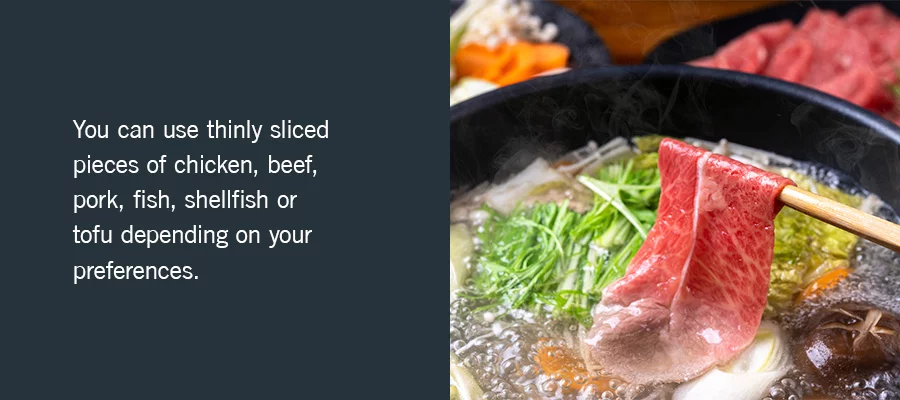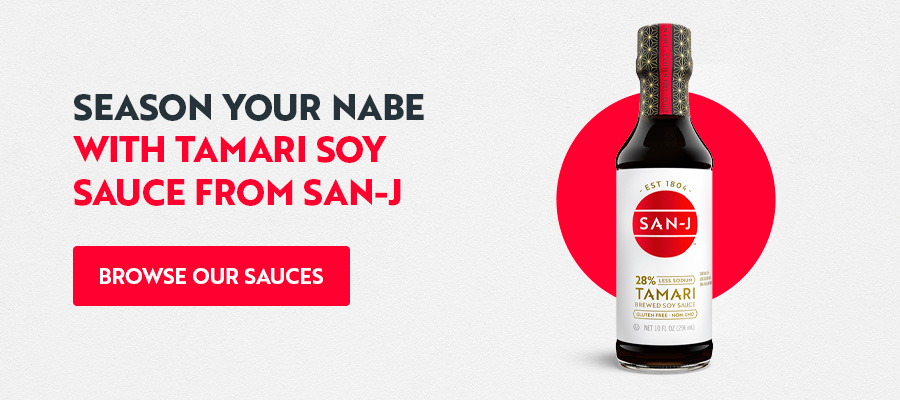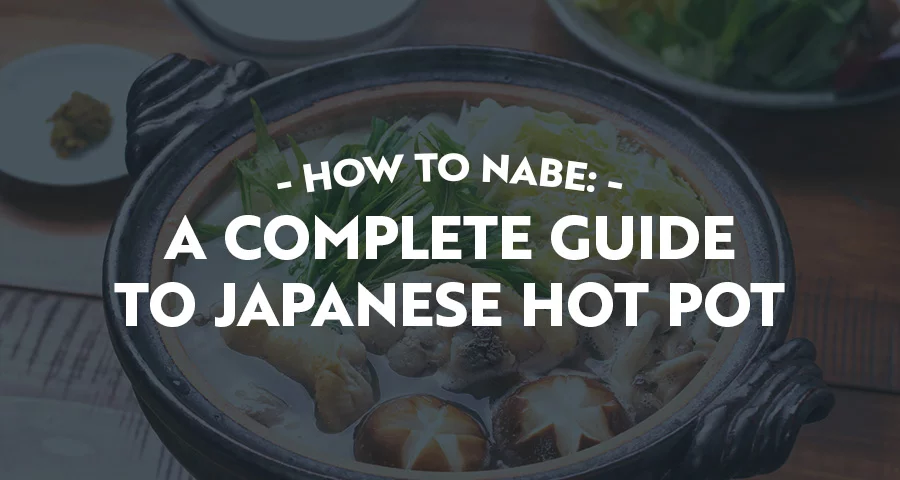Nabe has been a staple in Japanese cuisine for over a thousand years and is still wildly popular today. Learning how to eat and cook nabe is an excellent way to learn more about Japanese culture.
What Is Nabe?
“Nabe” is short for “nabemono,” which is a catch-all term for any Japanese hot pot dish. Hot pot is a communal meal similar to fondue in the West — everyone sits around the table and takes piping hot food straight from the pot.
It’s a great way to warm up during the cold winter months. And with the mix of protein and vegetables, nabe is a balanced, nutritious meal.
There are many different types of nabe, including many regional variations unique to certain parts of Japan. Some of the most popular variations include:
- Yosenabe: As the most flexible style of nabe, yosenabe can include anything — it’s basically a “freestyle” hot pot. You can swap out any ingredient you like depending on your tastes and what you have available.
- Shabu-shabu: This popular dish contains meat and vegetables cooked in dashi, a flavorful broth made using dried kombu (or edible kelp). You’ll usually find it served with a variety of dipping sauces.
- Mizutaki: Mizutaki is a chicken-based hot pot that combines chicken with vegetables, tofu and mushrooms in a light dashi. It’s frequently served with ponzu sauce.
- Nabeyaki udon: This variety features thick, chewy udon noodles in dashi. Other common ingredients include fried tofu, egg, chopped green onions and kamaboko fish cakes.
- Chanko nabe: Sumo wrestlers eat this “sumo stew” every day as part of their training. While there are no specific rules around what ingredients to use, it usually contains massive quantities of vegetables and lots of protein in a rich broth.
- Tomato nabe: This modern take on nabe adds an Italian twist with a tomato-infused chicken broth, olive oil, basil and even mozzarella cheese.
So how can you try nabe? If you’re in Japan, you can easily find hot pot at restaurants and house parties.
But you can still try it even if you’re unable to go to Japan. Some Asian and Japanese restaurants offer hot pot for large groups. You can also make delicious nabe at home with the right cooking equipment.
Ingredients for Japanese Hot Pot

Thinking of cooking Japanese hot pot at home? Here are the ingredients you’ll need for an easy yosenabe:
- Broth: A flavorful broth is essential because it forms the base of your whole meal. Authentic Japanese hot pot recipes call for some variant of dashi, a Japanese soup stock traditionally made from kombu, bonito flakes and dried mushrooms.
- Vegetables: Traditional hot pot veggies include napa cabbage, carrot, green onions and chrysanthemum leaves, but yosenabe is also a great way to use up any extra vegetables you might have in your fridge.
- Proteins: You can use thinly sliced pieces of chicken, beef, pork, fish, shellfish or tofu depending on your preferences.
- Mushrooms: Mushrooms add a complex, earthy flavor to your dashi that enriches the entire meal. You can use shimeji, enoki, maitake or shiitake mushrooms.
- Seasonings: Typical seasonings include sake, mirin and Soy Sauce. For best results, use high-alcohol mirin — the alcohol will provide a pleasant aroma and add a sweet umami flavor to the pot.
- Toppings: Garnish your pot with a sprinkle of chopped green onion, shichimi togarashi or yuzu zest.
You may also choose to serve your nabe with a dipping sauce, especially if you’re using a lighter soup base. Two common options are ponzu, which is a tangy citrus-based sauce, and goma dare, a creamy sauce made from sesame seeds.
“”Anyone who loves to cook knows the right equipment is just as important as the right ingredients. While you could cook your ingredients in a large pot on your stove, you’ll need the following to cook at the table:
- Donabe: A donabe is a traditional Japanese earthenware pot, and it’s an excellent item to have on hand if you enjoy hot pot. You can also use a large braiser, flat-bottomed wok or Dutch oven.
- Portable stove: Depending on what kind of pot you have, you can use either a butane burner or an induction burner. A butane stove is best for traditional donabe, while an induction burner can work well for any magnetic pot with a flat bottom.
- Cooking utensils: You’ll need several pairs of metal tongs or cooking chopsticks to handle the ingredients — designate one pair for each ingredient to avoid cross-contamination. Ladles and a fine mesh skimmer are also helpful for serving.
- Serving dishes: Provide your guests with individual serving bowls or plates so they can easily dish up.
- Side tray: It’s also helpful to have a large bamboo tray or plate to hold your uncooked ingredients until you’re ready to place them in the pot.
You’ll also need plenty of people to share your meal with you. A hot pot party is a fun and tasty way to spend time with your loved ones while trying new cuisines.
How to Cook Japanese Hot Pot
Before you do anything else, prep your veggies and proteins. Having them ready in advance will make cooking them a much easier process. Using a food processor or mandoline can help you cut down on prep time. You can also recruit one or two of your guests to help out.
After prepping your ingredients, it’s time to get cooking. Gather everyone around the table and follow this Japanese hot pot recipe:
- Heat the pot: Simmer 4 cups of water with dried kombu on medium-low heat for about 20-30 minutes. Try not to let the water boil. Once it’s heated up, remove and discard the kombu.
- Bring the water to a boil: Turn the heat up to high and bring the water to a boil.
- Add katsuobushi: Add katsuobushi and let simmer for 30 seconds. Turn off the heat and let the mixture steep for about 10 minutes.
- Strain the stock: Strain the stock into a large bowl.
- Add Soy Sauce: Pour the dashi into a pot and add SAN-J Tamari Soy Sauce, mirin and sake. Cover, bring to a simmer and then turn off the heat.
- Set up: Set your table with the serving bowls and plates, and get your portable stove ready in the center. Make sure it’s within arm’s reach for everyone at the table. Gather all of your prepped ingredients.
- Bring the soup broth to a boil: Bring your broth to a boil on your portable stove.
- Simmer ingredients: Once it’s heated up, add your ingredients. First, add the vegetables that take a long time to cook, like carrots. Arrange the ingredients in the pot into separate sections to make it easier for your guests to grab what they want. Cover and let the ingredients cook thoroughly. You can serve appetizers or side dishes in the meantime.
- Serve: Once the food is cooked, it’s time for everyone to dig in! You can turn down the heat to keep everything warm, but be careful when dishing up. When you notice the pot is empty, add more ingredients and cook again. Continue until you run out of ingredients or everyone is satisfied.
- Shime, or “finish it up”: After you’ve finished up all your ingredients, add rice or cooked noodles to the pot. All the flavors of the food mix together to create a delicious broth perfect for rice porridge or noodle soup.
After the meal, relax and enjoy the company of your guests before it’s time to clean up.
Season Your Nabe With Tamari Soy Sauce From SAN-J
If you’re thinking of hosting a hot pot party soon, consider adding our flavorful sauces to your shopping list. Our Organic Tamari Soy Sauce will add a splash of umami-rich flavor to your broth. And because we brew our Tamari Soy Sauce without wheat, it’s certified gluten-free by the Gluten-Free Certification Organization — perfect for entertaining guests with dietary restrictions.
Browse our sauces online to learn more, or click here to locate our products at a store near you.



